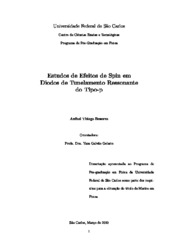| dc.contributor.author | Bezerra, Anibal Thiago | |
| dc.date.accessioned | 2016-06-02T20:16:46Z | |
| dc.date.available | 2010-06-29 | |
| dc.date.available | 2016-06-02T20:16:46Z | |
| dc.date.issued | 2010-03-26 | |
| dc.identifier.citation | BEZERRA, Anibal Thiago. Estudos de efeitos de spin em diodos de tunelamento ressonante do tipo-p. 2010. 102 f. Dissertação (Mestrado em Ciências Exatas e da Terra) - Universidade Federal de São Carlos, São Carlos, 2010. | por |
| dc.identifier.uri | https://repositorio.ufscar.br/handle/ufscar/5026 | |
| dc.description.abstract | The aim of this work was to complement the studies of the mechanisms of control of the degree of circular polarization of emission from resonant tunneling diodes p-type (RTD) by analyzing the optical properties and transport of this type of structure. We focus primarily on the influence of the width of quantum well to these properties and the possible injection of spin-polarized charge carriers, from the two-dimensional hole gas formed in the accumulation layer adjacent to the barriers. First, we discuss the theoretical foundations necessary for understanding the work, followed by the description of samples and experimental methods to perform this study. The results showed that the degree of circular polarization of luminescence of the quantum well is strongly correlated with the transport across the diode and with the separation of the emission energy of each spin component. We note also that reversal signal degree of polarization in the regions of resonant tunneling, which were associated with different Landè g-factors of electrons and holes and the injection through the spin channels. Regarding the issue of contacts emition, we observed the presence of two major contributions, one related to the three-dimensional contact and other related two-dimensional hole gas formed in the accumulation layer. The luminescence of gas did not show significant spin polarization, preventing direct analysis of its influence on the spin properties of quantum well. Finally, we conclude that the variation in width of the quantum well can greatly influence the spin properties of RTDs, and the study of these properties may allow the architecture of new spintronic devices. | eng |
| dc.description.sponsorship | Universidade Federal de Sao Carlos | |
| dc.format | application/pdf | por |
| dc.language | por | por |
| dc.publisher | Universidade Federal de São Carlos | por |
| dc.rights | Acesso Aberto | por |
| dc.subject | Física do estado sólido | por |
| dc.subject | Spintronics | por |
| dc.subject | Diodos | por |
| dc.subject | Fotoluminescência | por |
| dc.subject | Transporte eletrônico | por |
| dc.title | Estudos de efeitos de spin em diodos de tunelamento ressonante do tipo-p | por |
| dc.type | Dissertação | por |
| dc.contributor.advisor1 | Gobato, Yara Galvão | |
| dc.contributor.advisor1Lattes | http://lattes.cnpq.br/7558531056409406 | por |
| dc.description.resumo | Esse trabalho teve como objetivo complementar os estudos dos mecanismos de controle do grau de polarização circular da emissão proveniente de diodos de tunelamento ressonante do tipo-p (RTD), por meio da análise das propriedades ópticas e de transporte desse tipo de estrutura. Nos focamos basicamente na influência da largura do poço quântico nessas propriedades e da possível injeção de portadores de carga spin-polarizados, provenientes do gás bidimensional de buracos formado na camada de acumulação adjacente às barreiras. Primeiramente, discutimos os fundamentos teóricos necessários para o entendimento do trabalho, seguido da descrição das amostras e os métodos experimentais utilizados para a execução desse estudo. Os resultados demonstraram que o grau de polarização circular da luminescência do poço quântico está fortemente correlacionado com o transporte através do diodo e com a separação em energia das emissões de cada componente de spin. Verificamos ainda inversões de sinal desse grau de polarização nas regiões de tunelamento ressonante, as quais foram associadas aos diferentes fatores-g de Landè dos elétrons e dos buracos e à injeção através dos canais de spin. Com relação à emissão dos contatos, observamos a presença de duas contribuições principais, uma relacionada ao contato tridimensional e outra relacionada ao gás bidimensional de buracos formado na camada de acumulação. A emissão desse gás não apresentou polarização significativa de spin, impossibilitando a análise direta de sua influência nas propriedades de spin do poço quântico. Por fim, concluímos que a variação na largura do poço quântico pode influenciar muito nas propriedades de spin de RTDs, afetando diretamente o fator-g de Landè dos portadores de carga, e que o estudo destas propriedades abre portas para a arquitetura de novos dispositivos spintrônicos. | por |
| dc.publisher.country | BR | por |
| dc.publisher.initials | UFSCar | por |
| dc.publisher.program | Programa de Pós-Graduação em Física - PPGF | por |
| dc.subject.cnpq | CIENCIAS EXATAS E DA TERRA::FISICA | por |
| dc.contributor.authorlattes | http://lattes.cnpq.br/8478305453281130 | por |
